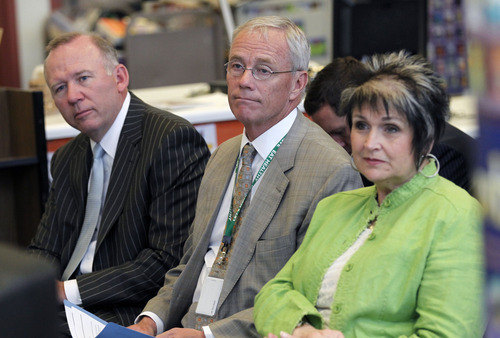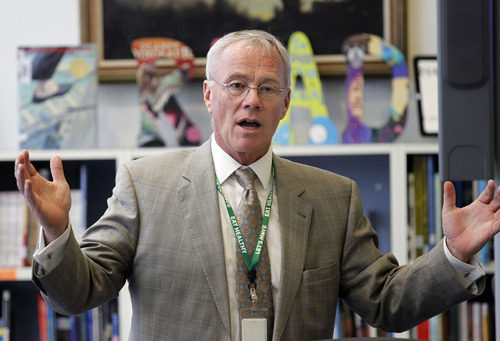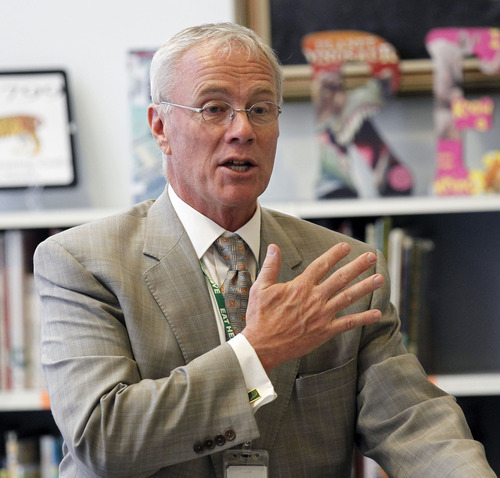This is an archived article that was published on sltrib.com in 2012, and information in the article may be outdated. It is provided only for personal research purposes and may not be reprinted.
Teacher Heather Musser sat directly across from first-grader Benjamin Blake as he read a story about hats Tuesday.
But she wasn't just listening.
She followed along on an iPad as he read, marking mistakes. When he finished, she asked him to describe what he had read, and again, marked his responses on the device. Instantly, scores describing Benjamin's fluency, accuracy and comprehension popped up on her screen.
"It's just a much better way to test," said the teacher at Roosevelt Elementary in Salt Lake City. "It would take three times as long to do it the old way as it does the new way. ... We can now spend a lot more time teaching rather than testing."
The new testing technology is now being used by more than half the state's school districts and 22 charter schools thanks to a $3 million bill passed by lawmakers in 2011. Some criticized HB302 at the time, partly for putting money toward a new program in a time of budget woes. But on Tuesday state leaders gathered at Roosevelt to praise the software and what it's meant for Utah classrooms.
Sherrie Kendall, a Roosevelt literacy coach, called the new program a "tremendous time-saver," saying it reduced the time teachers must spend testing young kids' literacy at Roosevelt by as much as two hours a week.
"For several years we've been using reading assessments across the state to provide teachers with data but…a lot of time has been spent managing the data," said State Superintendent Larry Shumway. "Rather than spend time managing the data what we hope we can provide are tools that will allow teachers to spend far more time responding to the data."
Starting next school year, elementary schools throughout the state will be required to give the early-grades literacy test called DIBELS, or a test like DIBELS, three times a year. This year they were required to give it once. But some schools, like Roosevelt, check progress using DIBELS more often.
The test takes only about two minutes to administer to each student, but teachers spend several more minutes per student to score the tests and enter the results into their computers, Kendall said. The new program eliminates the last step and gives teachers immediate results.
Two or three minutes less might not seem like much, but multiply that by 28 — the size of a typical first-grade classroom at Roosevelt — and it can save teachers significant time, Kendall said. Many teachers at Roosevelt, which has a lot of at-risk students, give tests as often as weekly. About 12 percent of the school's students are refugees and about 85 percent of Roosevelt's kids qualify for free or reduced lunch assistance.
"The pressure on schools to have every child reading at grade level by third-grade is immense, especially in a school with our risk factors," said Roosevelt Principal Jennifer Keil-Reed. "With these time-saving technology tools teachers can spend less time assessing and focus more on effective planning for instruction that meets the individual needs of our students."
Rep. Merlynn Newbold, R-South Jordan, said she sponsored the bill behind the program in hopes of boosting reading achievement in Utah by giving teachers better data and more time to act on it.
Midway through last school year, 77 percent of Utah third-graders were reading on grade level, according to the State Office of Education.
At the time of the bill's passage some expressed concern that it was tailored for a specific product vendor. But Newbold said Tuesday the bill was "carefully constructed not to cater to anyone. It was very broad in its scope so that we could allow the State Office [of Education] to get as many bids as possible so the state could get the best product."
Ultimately, Wireless Generation, a national education company, submitted the winning bid.
Some also criticized the bill for putting money toward a new education program, but Shumway said Tuesday that $3 million is a relatively small investment to improve education.
"At some point you have to invest in making the rest of your operation more effective and that's part of what this is," Shumway said.
The technology is optional, but available to any school that wants to use it, Newbold said.
"Instead of spending hours doing paperwork," Newbold said, "they can actually quickly digest the results, identify the patterns that are happening with their students and focus on instruction, which is where learning takes place, not in assessment."
Twitter: @lschencker















